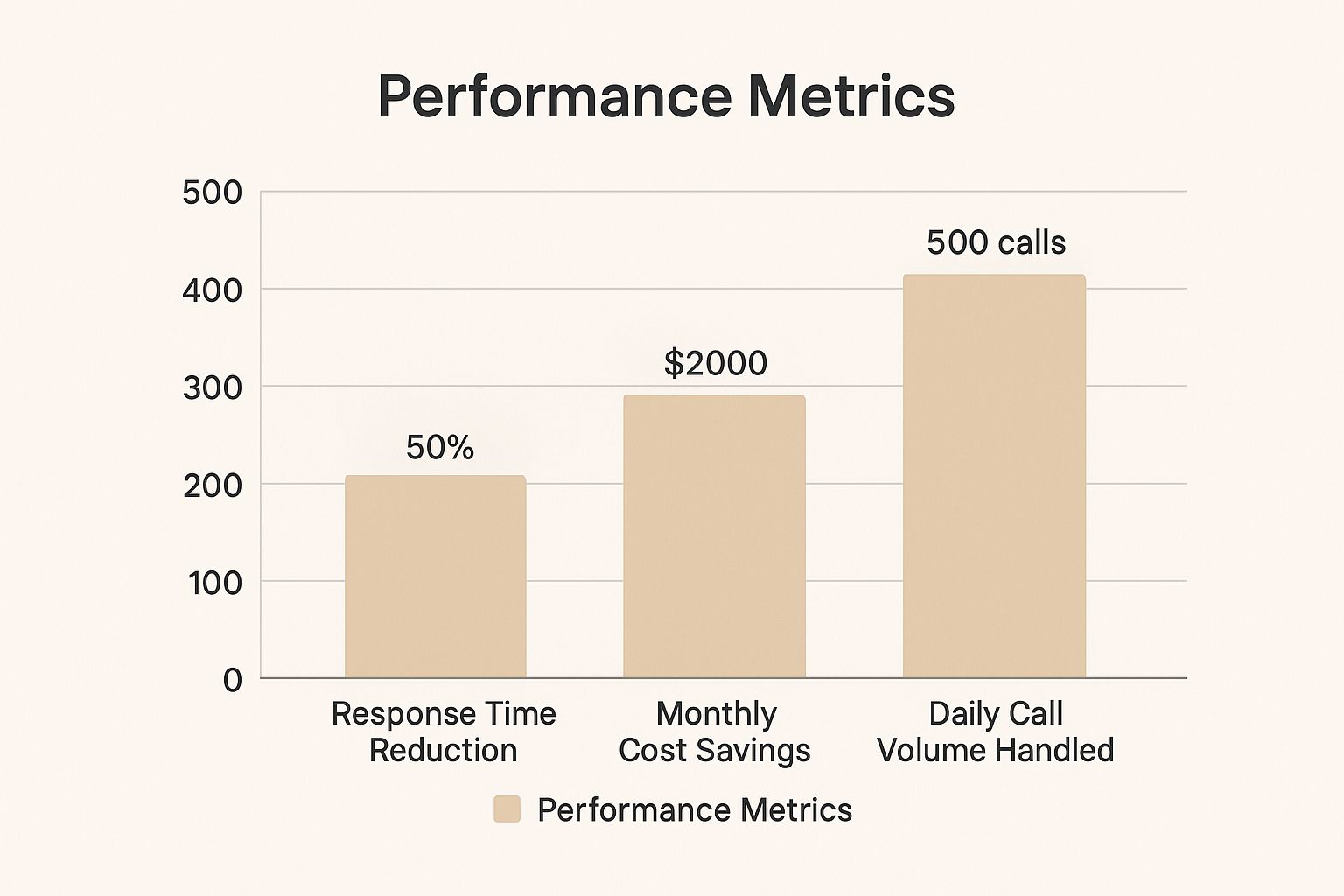Understanding Modern Automated Phone Answering Systems

Automated phone answering systems have evolved significantly from basic voicemail. They now represent a major shift in how Australian businesses handle customer interactions. These systems have become advanced platforms that use technology to boost efficiency and improve the customer experience, driven by the growing need for seamless, 24/7 service.
From Voicemail to Virtual Receptionist
Initially, automated systems primarily took messages. Now, features like intelligent call routing, voice recognition, and CRM integration are transforming them into virtual receptionists. This results in quicker responses, better call handling, and more personalized customer interactions.
For example, a caller can be automatically routed to the correct department or given self-service options. This reduces wait times and boosts overall satisfaction.
The Power of AI in Automated Systems
Artificial intelligence (AI) is crucial in modern automated phone answering systems. AI powers features like natural language processing, allowing the system to understand and respond to spoken requests conversationally.
AI also enables sentiment analysis, helping businesses understand caller emotions and tailor responses appropriately. This personalization is key to building stronger customer relationships.
The Australian call centre industry has seen significant progress in adopting these systems. By using AI-driven technologies, businesses are improving customer service efficiency and satisfaction. AI-powered chatbots and virtual assistants are becoming essential for managing inquiries, freeing human agents to handle complex issues. Find more detailed statistics here.
Benefits for Australian Businesses
These advanced systems offer numerous benefits, providing tangible improvements for Australian businesses. Improved call handling efficiency means fewer missed calls and shorter wait times, directly increasing customer satisfaction and boosting brand reputation.
By automating routine tasks, businesses can free up staff to focus on complex issues and strategic initiatives. This leads to higher productivity and better resource allocation. These systems also provide valuable data insights into customer behavior and call patterns, allowing businesses to refine strategies and optimize their customer service.
Choosing the Right System for Your Business
Choosing the right automated phone answering system is critical for success. Consider factors like your business size and type, specific customer service needs, and budget.
A well-chosen system improves customer interactions, streamlines operations, and contributes to overall business growth. Look for a system that offers scalability and flexibility, allowing it to adapt to your changing needs.
Essential Features That Drive Real Business Results
Not all automated phone answering systems are created equal. Some offer just the basics, while others provide advanced features that can truly elevate your business. This section explores those key features – the ones that differentiate a simple answering system from a solution that drives real business results in Australia.
Intelligent Call Routing: Connecting Customers Efficiently
Intelligent call routing takes call management to the next level. It's more than just directing calls to different departments; it analyzes caller input and uses this information to connect them with the most suitable agent. This ensures customers quickly reach the right person, reducing frustration and improving first-call resolution rates. Imagine a customer calling about a specific product and being routed directly to a product specialist, eliminating unnecessary transfers.
Intelligent call routing also considers factors like agent availability and skillset to ensure calls are handled efficiently and effectively, leading to shorter wait times and increased customer satisfaction. Learn more about intelligent call routing and its benefits: How to master intelligent call routing.
Voicemail Transcription: Streamlining Communication
In today’s busy business environment, voicemails can easily get lost or overlooked. Voicemail transcription converts these voice messages into text, making them much easier to manage and respond to. This ensures important information isn’t missed, and staff can quickly address customer inquiries.
This is especially useful for businesses that receive a high volume of voicemails or have remote staff. Voicemail transcription simplifies reviewing messages, prioritizing responses, and ensuring every customer is heard.
Multi-Language Support: Catering to a Diverse Market
Australia is a multicultural country, and businesses need to cater to a diverse customer base. An automated phone answering system with multi-language support can greet callers in their preferred language, fostering a more welcoming and inclusive customer experience.
This is vital for businesses operating in areas with large non-English speaking populations. Offering multi-language support can significantly boost customer satisfaction and expand a business's market reach.
Advanced Capabilities: Elevating Customer Service
Beyond the essential features, advanced capabilities can have a major impact on business outcomes. Sentiment analysis, for example, can gauge the caller's emotional state and route them to an agent trained to handle sensitive situations. Predictive routing uses historical data to anticipate customer needs and connect them with the most appropriate agent.
These advanced capabilities empower businesses to personalize the customer experience, improving overall satisfaction. They also provide valuable insights into customer behavior and preferences.
Integration and Customization: Tailoring Solutions
A truly effective automated phone answering system integrates seamlessly with existing business tools, like CRM systems and marketing platforms. This streamlines workflows and improves data management. Customization is also key, allowing businesses to tailor the system to their specific branding and customer service needs.
The infographic below visualizes the impact of an effective automated phone answering system: a 50% reduction in response time, $2000 in monthly cost savings, and the capacity to handle 500 calls daily.

These improvements translate into tangible business benefits, including increased customer satisfaction and better operational efficiency. Choosing the right system with the right features is essential for achieving these results.
The following table compares essential features with advanced capabilities, outlining their business impact and implementation effort.
To help businesses understand the value proposition of different features, we've compiled a comparison table. This table illustrates the key differences between basic and advanced systems, highlighting their respective business impact and implementation effort.
| Feature | Basic Systems | Advanced Systems | Business Impact | Implementation Effort |
|---|---|---|---|---|
| Call Routing | Basic departmental routing | Intelligent routing based on caller input | Improved first-call resolution, reduced wait times | Medium |
| Voicemail | Standard voicemail boxes | Voicemail transcription to text | Enhanced message management, faster response times | Low |
| Language Support | Limited or no multi-language support | Multi-language greetings and routing | Improved customer experience, broader market reach | Medium |
| Sentiment Analysis | Not available | Detects caller emotions | Personalized customer service, improved handling of sensitive situations | High |
| Predictive Routing | Not available | Anticipates customer needs | Proactive customer service, increased efficiency | High |
| Integration with CRM | Limited or no integration | Seamless CRM integration | Streamlined workflows, improved data management | Medium |
| System Customization | Limited options | Extensive customization possibilities | Brand consistency, tailored customer service experiences | Medium |
This comparison highlights how investing in advanced features can significantly enhance customer experience and operational efficiency, although it may require more initial setup. Choosing the right balance of features depends on your specific business needs and budget.
Solving Australia's Unique Customer Service Challenges

Australian businesses face a unique set of customer service hurdles. Managing expectations across vast distances and varied time zones is a major one. Catering to a diverse population while maintaining the high level of personalized service Aussies expect adds another layer of complexity. This is where an automated phone answering system can become a valuable tool. It allows businesses to address these challenges head-on, improving both customer satisfaction and operational efficiency.
Tackling After-Hours Coverage and Time Zone Differences
A key advantage of automated phone answering systems is 24/7 availability. This is particularly beneficial for businesses operating across Australia's different time zones or serving international clients. Customers can always reach someone, regardless of the time. This eliminates the restrictions of traditional business hours and provides a consistent contact point. Ultimately, it improves accessibility and customer satisfaction, allowing Australian businesses to compete more effectively on a global scale.
Maintaining a Personal Touch With Automation
While efficiency is paramount, Australian customers still value a personal touch. A well-designed automated phone answering system can deliver this. Customized greetings and intelligent call routing based on customer needs are a good start. Offering self-service options for straightforward inquiries also helps. For example, a customer calling about a specific product can be routed directly to a product specialist, ensuring they receive prompt, expert assistance.
Addressing Concerns About Impersonal Interactions
Some businesses worry about automation creating impersonal interactions. However, modern automated systems, especially those powered by AI, are designed to be conversational and empathetic. Features like natural language processing and sentiment analysis allow these systems to understand customer emotions and tailor responses accordingly. This helps maintain a human-like interaction while still leveraging the efficiency of automation. You might be interested in learning more about conditional call forwarding.
Improving Consistency and Reducing Wait Times
Long wait times and inconsistent service quality are ongoing challenges for the Australian call centre industry. Industry rankings often cite average wait times and customer satisfaction levels as critical performance indicators. Automated phone answering systems can help reduce wait times. However, careful integration is crucial to maintain customer satisfaction. You can explore this further with information on Predictive Dialer in Australia. Automated systems also promote consistency by providing standardized responses and adhering to set processes. This reduces the variability common in human interactions and creates a more predictable, reliable customer experience.
Real-World Australian Success Stories
Many Australian businesses have successfully used automated phone answering systems to address their specific challenges. One example is a national retail chain that implemented a system to manage after-hours stock inquiries. This significantly reduced customer wait times and freed up staff to focus on in-store customer service. Another example is a healthcare provider that implemented an automated appointment reminder system, leading to fewer missed appointments and improved patient engagement. These successes demonstrate the tangible benefits of integrating automation into Australian business operations.
Smart Investment Analysis For Australian Businesses
Investing in an automated phone answering system can be a smart move for Australian businesses wanting to improve efficiency and customer satisfaction. But figuring out the real return on investment (ROI) means looking past the initial cost. This section breaks down the key investment factors to help you make a well-informed decision.
Understanding the Cost Components
The overall cost of an automated phone answering system includes several components:
-
Software Licensing: This is usually a recurring monthly or annual fee based on the number of users, features included, and your call volume. Many providers offer tiered pricing plans, so you can choose a package that suits your needs and budget.
-
Hardware Requirements: You might need to invest in new hardware like VoIP phones or servers, depending on the system. Many modern systems are cloud-based, though, which minimizes hardware costs.
-
Ongoing Support: Consider the cost of technical support and maintenance. Look for providers offering reliable 24/7 support to minimize any service interruptions.
-
Staff Transition Costs: Setting up a new system may require staff training and changes to existing workflows. Be sure to include these costs in your overall analysis.
Analysing Different Pricing Models
Automated phone answering systems typically use several pricing models. Per-user pricing charges a set fee per user each month. Usage-based pricing charges based on the number of calls or minutes used. Some providers also offer customized plans designed for specific business needs. Understanding these models helps you choose the most cost-effective option for your business.
For example, a small business with low call volume might find a per-user model more affordable, while a busy call centre might prefer a usage-based approach.
Calculating ROI and Payback Period
Calculating the ROI of an automated phone answering system means assessing potential cost savings and revenue gains. These benefits can include:
-
Reduced Labour Costs: Automating your phone system can reduce the need for dedicated receptionists, freeing up existing employees for other tasks.
-
Improved Efficiency: Streamlined call handling and shorter wait times improve overall efficiency and productivity.
-
Enhanced Customer Retention: Better customer service and 24/7 availability lead to improved customer satisfaction and loyalty.
By putting a number on these benefits and comparing them to the total cost, you can determine the ROI and estimated payback period.
Real-World Examples in Australia
Many Australian businesses have achieved significant returns from investing in automated phone answering systems. One retail business in Sydney reduced customer wait times by 50%, leading to a boost in sales. A healthcare provider in Melbourne improved appointment scheduling efficiency by 30%, which resulted in fewer missed appointments.
These real-world examples show the tangible benefits possible through strategic implementation.
Cost Breakdown by Business Size
The table below shows example cost breakdowns and ROI projections for small, medium, and large businesses in Australia. These are sample figures and will differ depending on the specific system and provider you choose. It’s designed to give you a general idea of potential costs and returns.
To help you evaluate the financial implications of implementing an automated phone answering system, we've compiled a cost breakdown table:
| Business Size | Setup Costs | Monthly Fees | Annual Savings | ROI Timeline | Break-even Point |
|---|---|---|---|---|---|
| Small | $500 | $100 | $3,000 | 12 Months | 2 Months |
| Medium | $1,000 | $250 | $8,000 | 8 Months | 4 Months |
| Large | $2,000 | $500 | $15,000 | 6 Months | 5 Months |
As you can see, the initial setup costs vary based on business size. However, the potential annual savings and relatively short ROI timelines demonstrate the potential value of this investment across different scales of operation.
By carefully considering the costs, pricing models, and potential ROI, Australian businesses can make informed decisions about implementing an automated phone answering system. This investment can have a significant impact on customer service, operational efficiency, and your business’s long-term profitability.
Future-Proofing With AI and Emerging Technologies

For Australian businesses to remain competitive, their phone answering systems need to adapt to the ever-changing technological landscape. This means incorporating machine learning, predictive analytics, and voice biometrics. These technologies represent a significant change in how businesses connect with their customers.
Machine Learning: Systems That Learn and Improve
Machine learning is similar to training. With each interaction, the system refines its responses, becoming more precise and efficient. This applies to various aspects, from recognizing different accents to understanding complex inquiries.
For example, a machine learning algorithm can analyze past call data to anticipate future call volumes. This helps businesses effectively manage staffing levels and stay ahead in a competitive market.
Predictive Analytics: Anticipating Customer Needs
Predictive analytics goes a step further by anticipating customer needs. Imagine a system that understands why a customer is calling based on previous interactions, their location, or the time of day.
This allows businesses to proactively address customer issues, offer personalized solutions, and create a positive customer experience. The result? Happier customers and increased efficiency. You might be interested in: How to master intelligent call routing.
Voice Biometrics: Enhanced Security and Personalization
Voice biometrics provides enhanced security and personalization. By identifying a caller's unique voice, the system authenticates their identity, removing the need for passwords or security questions.
This simplifies the customer experience and enhances security, especially in industries like finance and healthcare where security is crucial.
Real-Time Sentiment Analysis: Understanding Customer Emotions
Real-time sentiment analysis is changing how businesses handle customer conversations. By analyzing a caller's tone and language, the system can understand their emotional state.
This information can route the call to the most suitable agent or adjust the automated response. For example, if a customer is frustrated, the system can offer an apology and prioritize their call.
AI-Driven Insights: Making Better Decisions
AI isn't just about automation; it's about providing valuable insights. By analyzing call data, customer interactions, and market trends, AI can identify areas for improvement and predict future customer behavior.
This data-driven approach empowers businesses to make strategic decisions and adapt to the dynamic Australian market. Choosing a system with these AI-driven insights is essential for long-term success. More detailed information can be found here: Call Center Automation Trends.
Implementation Strategy And Proven Best Practices
Implementing an automated phone answering system isn't just about adding new tech. It's about strategically integrating a solution that truly works for your business and improves your customer experience. This guide offers a practical roadmap for Australian businesses, from initial planning and choosing a vendor to staff training and system optimization.
Planning Your Implementation
Before starting, define your goals. What challenges are you trying to solve? Are you looking to reduce wait times, improve after-hours service, or streamline call routing? Understanding your objectives will inform your vendor selection and system configuration.
Next, assess your needs. Think about your call volume, the complexity of your call flows, and integration requirements with existing systems, like your CRM. This assessment helps determine the features you need in an automated phone answering system.
Choosing The Right Vendor
Choosing the right vendor is key for success. Research different providers and compare what they offer. Look for vendors with a proven track record in Australia.
- Intelligent call routing
- Voicemail transcription
- Multi-language support
Also, ensure they offer reliable technical support and ongoing maintenance.
Staff Training And Customer Adoption
Implementing a new system means change. Train your staff on the new system's features. This will help them use it effectively and confidently.
Address any staff concerns about technology replacing human interaction. Explain how the system supports their roles by handling routine tasks, freeing them to focus on complex customer needs.
Promote customer adoption by highlighting benefits like reduced wait times and better accessibility. Clear communication and positive feedback can make the transition easier.
Testing And Rollout
Before full launch, test thoroughly. This means testing call flows, voicemail transcription accuracy, and integration with other systems. A phased rollout helps you find and fix any issues before going live across your operation.
Begin by implementing the system in one department or with a small user group. Gather feedback during this phase and adjust as needed. This gradual approach minimizes disruption and allows for continuous improvement.
Ongoing Optimization And Compliance
After full implementation, ongoing monitoring and optimization are important. Track key metrics like call resolution rates, wait times, and customer satisfaction. This data helps pinpoint areas for improvement and refine your system.
Ensure your system complies with Australian telecommunications regulations and privacy laws. This includes adhering to data security standards and obtaining necessary consents for call recording.
Best Practices For Success
-
Keep it Simple: Design easy-to-navigate call flows. Avoid complex menus.
-
Personalize The Experience: Use custom greetings and messages. Address customers by name.
-
Offer Self-Service Options: Empower customers to solve simple issues themselves through automated menus and self-service features.
-
Provide A Seamless Transfer To Live Agents: Ensure smooth transitions to live agents when required. Provide context about previous interactions.
-
Gather Feedback And Continuously Improve: Regularly get feedback from staff and customers to identify areas for improvement and enhance effectiveness.
By following these strategies and best practices, Australian businesses can successfully use automated phone answering systems to improve customer service, streamline operations, and grow their business. Visit OnSilent to learn more.

